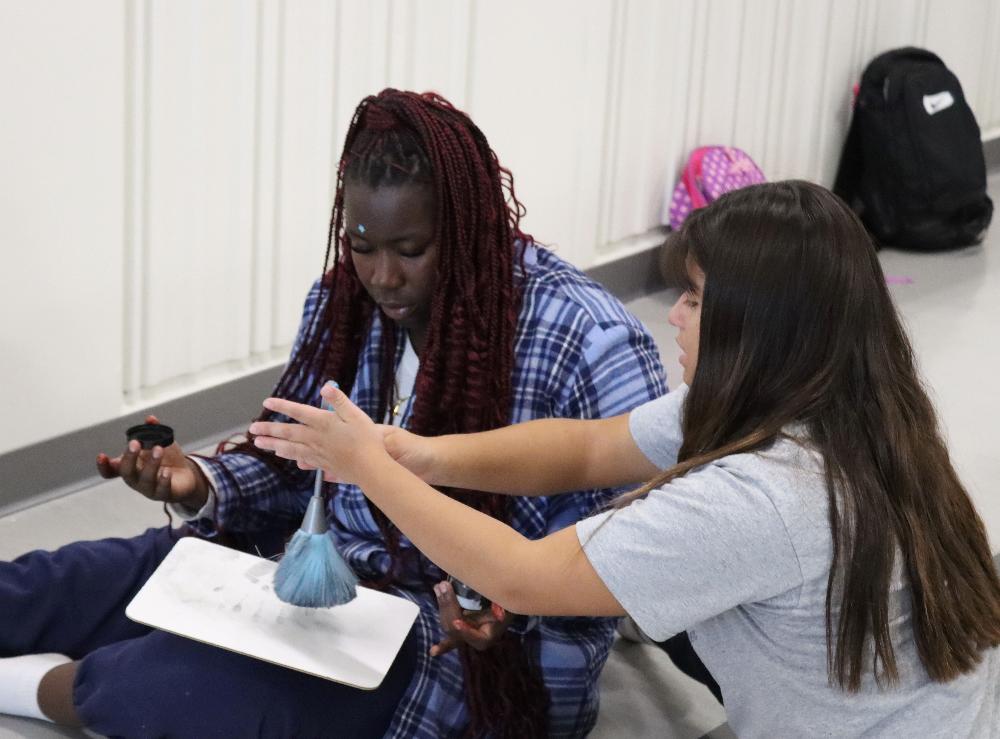Northwest students solve mysteries through forensic science class
October 16, 2024
Northwest High School students Betsabee, Antenai, Lucia and Arlette were sure they were making an unsolvable mystery as they painted blood splatters on a life-sized paper outline of a person.
The four Falcons were in the middle of creating their own crime scene as part of a forensic science course at school. Groups of students filled an upper hallway with fingerprints, blood spots and other vital clues for detectives. They then went up and down the hallway trying to crack their classmates’ cases.
Antenai said she and her three teammates liked how they had prepared their crime scene. They developed a storyline and then used brushes, markers, paint and other artistic tools to make the scenario come to life.
“It was very messy, but I think we’re going to throw them off,” Antenai said. “Everybody’s thinking that it’s one person who killed our person, but I think we’re going to throw them off. I think we did good.”
Fellow senior Shamarr felt the same type of confidence as his team worked on trying to decipher a puzzle near a window. They used a magnifying glass to look at the fingerprints of Mr. Addams, Mrs. Addams, Rosie, Daisy, Mrs. Addams’ sister and Rosie’s cousin. Rosie, the oldest daughter of Mr. and Mrs. Addams, had gone missing during a family vacation in Hawaii, and the family had called the police to try to find her.
“I think we accurately solved it,” Shamarr said. “There were a few things that we didn’t understand, but I think we ended up figuring it out at the end.”
Cindy Larson-Miller praised students as she watched them use an evidence-based process to unravel the mysteries. Larson-Miller is science department chair at Northwest and also leads classes at the Bryan College of Health Sciences Focus Program. She said the 16 Falcons in the course were gaining lifelong skills by learning how to gather facts and answer questions in a scientific way.
“I think it’s using what you see around you to figure something out,” Larson-Miller said. “You can apply that to any problem you have in your life, if you look around and you look at the evidence and you try to make sense of it and you look at things carefully. Even if that’s all they take away from it, I’m happy.”
Larson-Miller has taught forensic science classes for 12 years and is in year two of the program at Northwest. She and University of Nebraska-Lincoln student teacher Jon Matulka began the nine-week course in August by creating a crime scene for everyone to investigate. That set the stage for a full series of lessons and labs at school.
Larson-Miller and Matulka taught the Falcons how to examine fingerprints, bones and teeth at crime scenes during the class. They showed them how scientists extract DNA from hair and blood to collect clues about both the victim and villain, and they talked about the different techniques to gather and preserve physical evidence. They also shared information about investigators, psychologists, data analysts and other potential law enforcement careers.
Antenai said she has enjoyed learning about the forensic science profession. She has watched crime shows on television for many years, and she jumped at the chance to take the class when she found out about it.
“It was really fun,” Antenai said. “I didn’t know that I was going to enjoy this class so much, but I would always go home and I would tell my mom, ‘We lifted fingerprints today,’ and I was really excited. I liked this class.”
Shamarr said the class inspired him to consider becoming a crime scene investigator. He is now exploring the possibility of majoring in criminal justice in college, and he has visited several campuses with that in mind. He said Larson-Miller and Matulka have equipped everyone in the course with the knowledge they will need to be successful.
“I feel like if I would get into that sort of field, I would already know what I’m looking at,” Shamarr said. “I know what I’m doing right now. I really like it.”
In addition to providing a strong forensic science background, Shamarr said the class has also helped everyone develop teamwork skills. His group put together a storyline that included a teddy bear, empty glass, small purse and fingerprints of five people.
“You have to start asking questions, and then everybody’s ideas start pulling together, and then you get something really good that comes out of it,” Shamarr said. “I think what came out of our ideas was pretty good.”
Students on each team presented their theories about the other crime scenes they looked at during the final class period. Larson-Miller and Matulka will grade them based on how well they documented, preserved and judged the available evidence.
Larson-Miller said she believes the class will continue to grow at Northwest in future years. She said it is fun to watch students become actively interested in science.
“It’s so engaging that kids want to be here,” Larson-Miller said. “They want to learn. They realize that science can be fun, and I think it’s just really a way to reel kids into school.”
Visit home.lps.org/science to learn more about the wide range of enriching science classes available at Lincoln Public Schools.
Do you have a story idea? Share it with the LPS Communications Team by filling out this form!
Published: October 16, 2024, Updated: October 16, 2024

Northwest High School students Antenai and Lucia create fingerprint evidence for a crime scene in their forensic science course. Students put together crime scenes for their classmates to solve as part of a test. The class helped them learn how to gather facts and answer questions in a scientific way.
